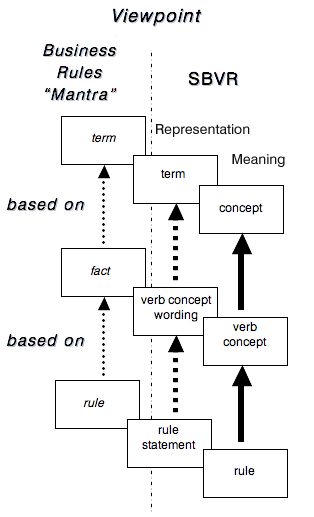SBVR Speaks: (3) How SBVR Supports the Business Rules Approach
In January 2008, the "Semantics of Business Vocabulary and Business Rules" (SBVR) was first presented by the Object Management Group (OMG) as an official specification of the OMG. Version 4 (SBVR 1.4) was published in 2017.[1]
The Semantics of Business Vocabulary and Business Rules (SBVR) provides a formal foundation for business rules. It also defines what they are. Much of the thinking in this area arose from the work of the Business Rules Group, which has been working exclusively in the area of business rules since the late 1980s.[3]
Key notions of the business rules approach are presented succinctly by the BRG's Business Rules Manifesto. An extract from the Manifesto is presented below, to assist readers in positioning some of the central notions of SBVR.[4] This brief extract is followed by a figure that gives an overview of SBVR support for key ideas of the business rules approach. We conclude with an illustration of this support from SBVR.
Key Notions of the Business Rules Approach
as expressed in the Business Rules Manifesto
Primary Requirements, Not Secondary. Rules are essential for, and a discrete part of, business models and technology models. Separate From Processes, Not Contained In Them. Rules apply across processes and procedures. There should be one cohesive body of rules, enforced consistently across all relevant areas of business activity. Deliberate Knowledge, Not A By-Product. Rules build on facts, and facts build on concepts as expressed by terms. Terms express business concepts; facts make assertions about these concepts; rules constrain and support these facts. Rules are basic to what the business knows about itself — that is, to basic business knowledge. Rules need to be nurtured, protected and managed. Declarative, Not Procedural. Rules should be expressed declaratively in natural-language sentences for the business audience. A rule is distinct from any enforcement defined for it. A rule and its enforcement are separate concerns. Well-Formed Expression, Not Ad Hoc. Business rules should be expressed in such a way that they can be validated for correctness by business people. Business rules should be expressed in such a way that they can be verified against each other for consistency. For the Sake of the Business, Not Technology. Rules are about business practice and guidance; therefore, rules are motivated by business goals and objectives and are shaped by various influences. The cost of rule enforcement must be balanced against business risks, and against business opportunities that might otherwise be lost. Of, By, and For Business People, Not IT People. Rules should arise from knowledgeable business people. Managing Business Logic, Not Hardware/Software Platforms. Rules, and the ability to change them effectively, are fundamental to improving business adaptability.
An Overview of SBVR Support for Key Business Rule Notions
A core idea of business rules formally supported by SBVR is the following from the Manifesto:
"Rules build on facts, and facts build on concepts as expressed by terms.
Terms express business concepts;
facts make assertions about these concepts;
rules constrain and support these facts."
This core idea, originating in the BRG's seminal 1995 white paper,[5] has been called the Business Rules 'Mantra'. It is often abbreviated for convenience to simply:
"Rules are based on facts, and facts are based on terms."
Figure 1 provides an overview of how SBVR supports the 'Mantra'. It requires a separation of viewpoints as follows:
Business Rules 'Mantra'. An approximation that simplifies explanation for business people and others new to the approach.
Representation (in SBVR terminology). The SBVR notions that classify the words that people use to express their vocabulary+rules.
Meaning (in SBVR terminology). The SBVR notions that classify the underlying meaning of the words that people use in expressing their vocabulary+rules.
Figure 1. How SBVR Supports the Business Rules 'Mantra'
An Illustration of this Separation of Concerns
In support of the separation of concerns shown in Figure 1, SBVR distinguishes subject areas for: the actual thing in the domain of interest, the meaning (concept) of that thing, the representation of the meaning by some form(s) of expression, and the raw expression. The following descriptions are taken from the introduction to the SBVR Vocabulary.
Extension: the things to which meanings refer, which can be anything (even expressions, representations and meanings when they are the subjects of our discourse).
Meaning: what is meant by a word (a concept) or by a statement (a proposition) — how we think about things.
Representation: the connection between expression and a meaning. Each representation ties one expression to one meaning.
Expression: things used to communicate (e.g., sounds, text, diagrams, gestures), but apart from their meaning — one expression can have many meanings.
Following are examples of how some things — like 'driver' (from the EU-Rent example) — cross through each subject area.
| Extension | Meaning | Representation | Expression |
| The actual drivers of motor vehicles | Concept 'driver' — how we think of drivers, what characterizes them | Designation of the concept 'driver' by the signifier "driver" | The character sequence "driver" |
| Definition of the concept 'driver' as "operator of a motor vehicle" | The character sequence "operator of a motor vehicle" | ||
| The actual City of Los Angeles, California — a real place | Individual concept 'Los Angeles' — how we think of that city, what distinguishes it from other places | 'Los Angeles' as a designation for the individual concept of 'Los Angeles' | The character sequence "Los Angeles" |
| For each car that is out of service, its actually being out of service | Characteristic applicable to a car — what is meant by a car being out of service | Verb concept wording 'car is out of service' as a template for the characteristic, with 'car' being a placeholder | The text "car is out of service" |
| The actual state of affairs of it being obligatory in the EU-Rent business that it not rent to a barred driver | Proposition — the meaning of the statement "EU-Rent must not rent to a barred driver" | The statement "EU-Rent must not rent to a barred driver" having the proposition as its meaning | The character sequence "EU-Rent must not rent to a barred driver" |
References
[1] Semantics of Business Vocabulary and Business Rules (SBVR). Object Management Group.
The current version of SBVR is available on the OMG
site. ![]()
[2] Quick Reference for Basic SBVR Terminology (v. 3)
[3] The Business Rules Group at www.BusinessRulesGroup.org ![]()
[4] The Business Rules Group, Business Rules Manifesto
~ The Principles of Rule Independence ver. 1.2 (Jan. 8, 2003). The full
text can be found (in several languages) at BusinessRulesGroup.org ![]()
[5] The Business Rules Group, Defining Business Rules
~ What Are They Really? 4th ed. (July 2000), formerly known as the "GUIDE
Business Rules Project Report," (1995). Available at BusinessRulesGroup.org ![]()
# # #
About our Contributor:
Online Interactive Training Series
In response to a great many requests, Business Rule Solutions now offers at-a-distance learning options. No travel, no backlogs, no hassles. Same great instructors, but with schedules, content and pricing designed to meet the special needs of busy professionals.












